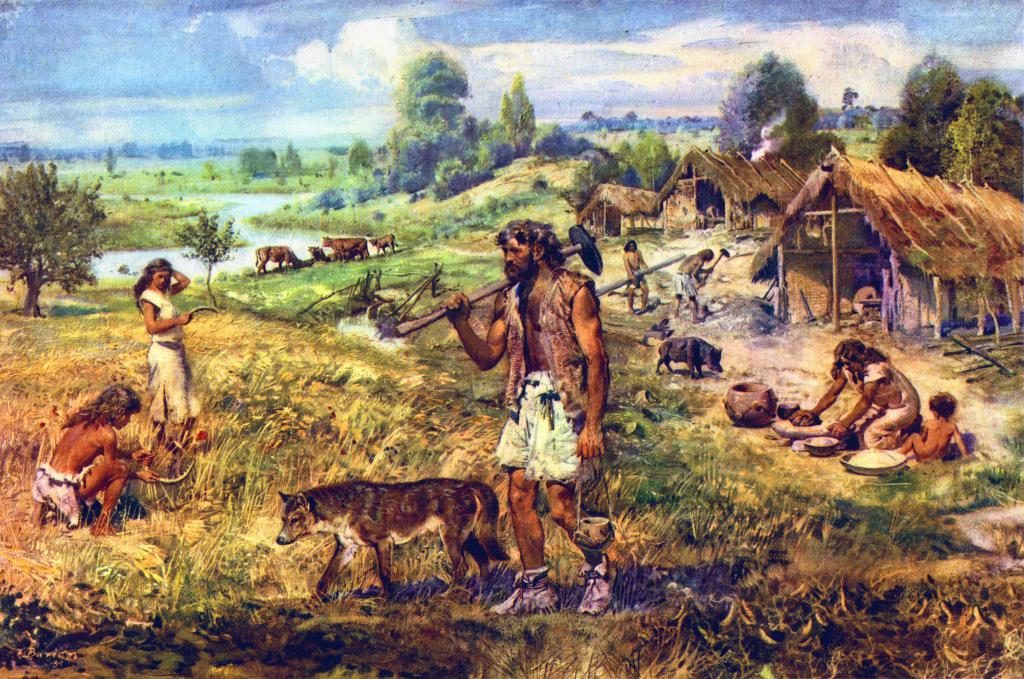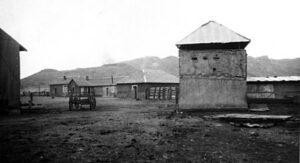Early humans before the neolithic era lived in small nomadic communities. Certain prehistoric communities started to make their own innovations regarding tools. They were able to start domesticating animals and growing plants for use, which would in turn allow them to start living in villages, or larger groups. The Neolithic Age was a period in the development of human technology, beginning about 10,000 BCE, in some parts of the Middle East, and later in other parts of the world, and ending between 4,500 and 2,000 BCE.
In earlier periods of time, people usually lived in non-permanent structures, such as tents, that could be picked up and transported very easily. Now with the development of agriculture, technology and the inventions of more sophisticated tools used in agriculture, people of the Neolithic Era were able to build permanent shelters. This gave them the ability to grow crops in the surrounding area. People started to develop their control over fire, which allowed for different uses soon after this. One of these uses of fire was the early stages of pottery. Humans began to dry clay for uses around the household. Hunting also became much easier to accomplish with the introduction new of stone tools. The most common tools used were daggers and spear points, used for hunting, and hand axes, used for cutting up different meats, and scrappers, which were used to clean animal hides.1

Advances in tool-making and domestic technology led to advances in agriculture. Farming started a revolution in the world and helped set us on a path that would eventually lead to the technological revolution and invention of different things. Inventions such as the plow helped in the planting of seeds. One essential benefit of the development of farming technology was the possibility of producing surplus crops, or food supplies that surpassed the immediate needs of the community. Surpluses could be stored for later use, or possibly traded for other necessities or luxuries. Agricultural life afforded securities that nomadic life could not, and farming in one place resulted in population growth far beyond that of hunters and gatherers. Soon after plant domestication began, animal domestication followed. The raising of cattle, sheep, and pigs for food replaced the necessity of daily hunting. The creation of stone tools also helped to advance the making of clothing. It was now possible to sheer wool and spin it into yarn to make more advanced clothing that made for better protection against the elements.2
Agriculture during this time period gave the human species a new feeling of security that their past way of life could not. However, this new way of living created new problems within the communities. Famines and pests yielded new diseases that the people of this era had not seen before. Sanitation became a problem due to the fact that most primitive villages did not have a proper form of waste disposal. Due to the fact that agriculture led to technological innovations it can be said that the Neolithic Era was the catalyst for the future of technology.3
- M.P. Richards, “A Brief Review of the Archaeological Evidence for Palaeolithic and Neolithic Subsistence,” European Journal of Clinical Nutrition 56, no. 12 (2002): Published Online. ↵
- Melanie Boyd, “The different paths of the neolithic revolution in Egypt and Sudan,” Anthrojournal Vol. 2 May 2014, Published Online. ↵
- Hugh James Freeman, “The Neolithic Revolution and Subsequent Emergence of the Celiac Affection,” International Journal of Celiac Disease 1, no. 1 (2013): 19–22. ↵



28 comments
Roman Olivera
The Neolithic ear was definitely when people started really thinking about settling in one place for the purpose of building a community. Thinking of all the different things that started in this era for farming tools, agriculture, and hunting equipment to name a few. The pottery was definitely a big deal for what they were able to store and the use of fire in the process for making many things. This was a prime time for innovation and once it started they just kept on making thing better and better for the idea of not having to be so nomadic .
Noah Bolhuis
In regards of the first humans in history, they may seem dumb and primitive to us in the 21st century, but they seem to actually have been very intelligent and innovative. They were able to, within a few short generations, go from a completely nomadic tribal structure to, as you said, able to develop stone tools, domesticate plants and animals, and set up permanent villages and towns. These discoveries were the stepping stone in growing a population to such high numbers.
John Smith
Despite how long ago the Neolithic Era occurred, I believe you can still learn a lot from it. It may not have been an age of conquests or culture, but there is something undeniable human about it. The development of tools and domestication of plants and animals is a huge statement about human ingenuity, a quality you can find in all of our roots, regardless of race or religion.
Destiny Flores
As simple as it is now to go to the store and get some apples, or corn, it’s easy to forget that it wasn’t always like that. Once humans discovered agriculture, or species as a whole was changed forever. Our way of life was changed forever. From nomads to villages and eventually complex societies. Although fairly small, if not for those first couple of simple tools, who knows where the human race would be today? Probably much much smaller.
Seth Castillo
The birth of technology came from the Neolithic era. To think that everything that where we are today started because our ancestors decided to create tools to help them in their daily struggles. Its an amazing feat for our species. We went from creating tools from bones and woods to creating artificial intelligence to completely automate everything in our day to day lives.
Grace Bell
This article does a great job at describing the adaptation of human civilization in the Neolithic Era and the many things they created in order to survive. It’s amazing to see how innovative our early ancestors were and how they were really able to overcome adversity and work as a community. This was a very well written article, you did a great job!
Brianda Gomez
Neolithic era was where it all began. This article caught my attention because I love learning about how our world used to be. It is truly amazing to learn how far we have come. From the fires to pottery to hunting. These were different skills that led to better innovations. We went from planting to farming and hunting. These helped people survived and have a better lifestyle. Now many years have passed since the Neolithic era and we do not have to do much of work like before.
Justin Garcia
The way human beings advanced over the years is always interesting. This article does a good job in explaining an era that started many innovations that are present to this day. Things such as axes, and permanent homes started in this era. We continue to innovate as human beings with technology to this day so it’s always great to learn about where we started. This was a good article.
Karina Nanez
Its incredible to think of how far the human race has come, and even more impressive that we are able to find neolithic age tools, proving that humans in this era were competent enough to think beyond just hunting and basic needs. This coupled with the eventual domestication and harvesting of plants that allowed for them to have a surplus of food and grow their populations shows us the exact moment when humans began to grow.
Steven Clinton
Interesting article, The people of the Neolithic era benefitted immensely with the invention of stone tools. The hunters could now go and efficiently kill bigger game animals. Also, the discovery of stone tools helped bring stability to a life of the nomads. Through agriculture, the people of Neolithic people adapted to a sedentary lifestyle. This is a great article keep it up!